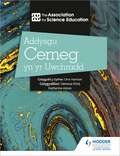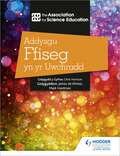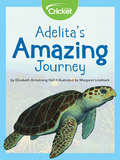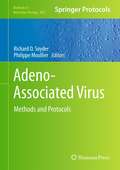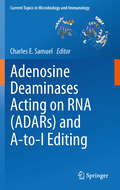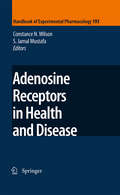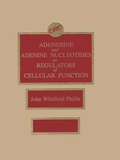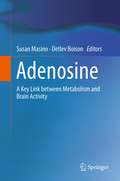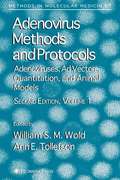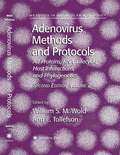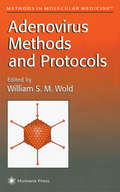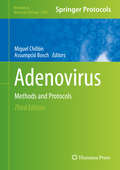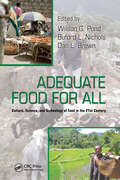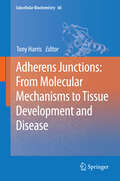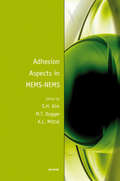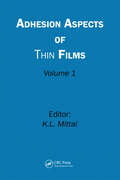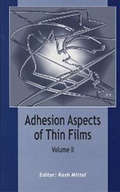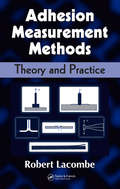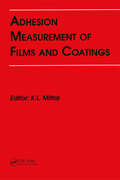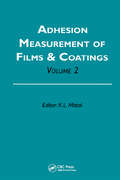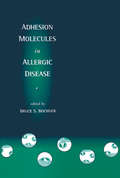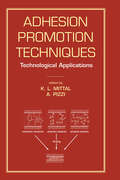- Table View
- List View
Addysgu Cemeg yn yr Uwchradd (Teaching Secondary Chemistry 3rd Edition Welsh Language edition)
by The Association EducationEnhance your teaching with expert advice and support for Key Stages 3 and 4 Chemistry from the Teaching Secondary series - the trusted teacher's guide for NQTs, non-specialists and experienced teachers.Written in association with ASE, this updated edition provides best practice teaching strategies from academic experts and practising teachers.- Refresh your subject knowledge, whatever your level of expertise- Gain strategies for delivering the big ideas of science using suggested teaching sequences- Engage students and develop their understanding with practical activities for each topic- Enrich your lessons and extend knowledge beyond the curriculum with enhancement ideas- Improve key skills with opportunities to introduce mathematics and scientific literacy highlighted throughout- Support the use of technology with ideas for online tasks, video suggestions and guidance on using cutting-edge software- Place science in context; this book highlights where you can apply science theory to real-life scenarios, as well as how the content can be used to introduce different STEM careersAlso available: Teaching Secondary Biology, Teaching Secondary Physics
Addysgu Ffiseg yn yr Uwchradd (Teaching Secondary Physics 3rd Edition Welsh Language edition)
by The Association EducationEnhance your teaching with expert advice and support for Key Stages 3 and 4 Physics from the Teaching Secondary series - the trusted teacher's guide for NQTs, non-specialists and experienced teachers.Written in association with ASE, this updated edition provides best practice teaching strategies from academic experts and practising teachers.- Refresh your subject knowledge, whatever your level of expertise- Gain strategies for delivering the big ideas of science using suggested teaching sequences- Engage students and develop their understanding with practical activities for each topic- Enrich your lessons and extend knowledge beyond the curriculum with enhancement ideas- Improve key skills with opportunities to introduce mathematics and scientific literacy highlighted throughout- Support the use of technology with ideas for online tasks, video suggestions and guidance on using cutting-edge software- Place science in context; this book highlights where you can apply science theory to real-life scenarios, as well as how the content can be used to introduce different STEM careersAlso available: Teaching Secondary Chemistry, Teaching Secondary Biology
Addysgu Ffiseg yn yr Uwchradd (Teaching Secondary Physics 3rd Edition Welsh Language edition)
by The Association EducationEnhance your teaching with expert advice and support for Key Stages 3 and 4 Physics from the Teaching Secondary series - the trusted teacher's guide for NQTs, non-specialists and experienced teachers.Written in association with ASE, this updated edition provides best practice teaching strategies from academic experts and practising teachers.- Refresh your subject knowledge, whatever your level of expertise- Gain strategies for delivering the big ideas of science using suggested teaching sequences- Engage students and develop their understanding with practical activities for each topic- Enrich your lessons and extend knowledge beyond the curriculum with enhancement ideas- Improve key skills with opportunities to introduce mathematics and scientific literacy highlighted throughout- Support the use of technology with ideas for online tasks, video suggestions and guidance on using cutting-edge software- Place science in context; this book highlights where you can apply science theory to real-life scenarios, as well as how the content can be used to introduce different STEM careersAlso available: Teaching Secondary Chemistry, Teaching Secondary Biology
Adelita's Amazing Journey
by Elizabeth Armstrong HallAdelita, a loggerhead sea turtle, was the first ocean-going animal to be tracked with a satellite transmitter. How would she find her way?
Adeno-Associated Virus: Methods and Protocols (Methods in Molecular Biology #807)
by Richard O. Snyder Philippe MoullierToday, progress in rAAV-mediated gene transfer is so robust that long-term, efficient, and regulatable transgene expression is reproducibly achieved in large animal models. The complexity of gene transfer agents in the context of their clinical use requires investigators from a wide variety of backgrounds to have an understanding -- or at least an appreciation of -- the regulatory environment and constraints that affect vector design, manufacturing, pre-clinical testing, and clinical use, with an emphasis on patient protection. In Adeno-Associated Virus: Methods and Protocols, experts from the United States and Europe have contributed current knowledge of this multi-dimensional field relating to the biology of AAV, rAAV vector design, vector manufacturing and product testing, performance of rAAV vectors in major organs, rAAV-related immunological issues, design of animal and clinical studies, and clinical experience. Written in the successful Methods in Molecular BiologyTM series format, chapters include introductions to their respective topics, lists of the necessary materials and reagents, step-by-step, readily reproducible protocols, and notes on troubleshooting and avoiding known pitfalls. Authoritative and accessible, Adeno-Associated Virus: Methods and Protocols provides a complete and comprehensive understanding of this multi-disciplinary and rapidly progressing field.
Adenosine Deaminases Acting on RNA (Current Topics in Microbiology and Immunology #353)
by Charles E. Samuel"The objective of this CTMI volume is to provide readers with a foundation for understanding what ADARs are and how they act to affect gene expression and function. It is becoming increasingly apparent that ADARs may possess roles not only as enzymes that deaminate adenosine to produce inosine in RNA substrates with double-stranded character, but also as proteins independent of their catalytic property. Because A-to-I editing may affect base-pairing and RNA structure, processes including translation, splicing, RNA replication, and miR and siRNA silencing may be affected. Future studies of ADARs no doubt will provide us with additional surprises and new insights into the modulation of biological processes by the ADAR family of proteins."
Adenosine Receptors in Health and Disease (Handbook of Experimental Pharmacology #193)
by Constance N. Wilson S. Jamal MustafaSince their discovery approximately 25 years ago, adenosine receptors have now emerged as important novel molecular targets in disease and drug discovery. These proteins play important roles in the entire spectrum of disease from inflammation to immune suppression. Because of their expression on a number of different cell types and in a number of different organ systems they play important roles in specific diseases, including asthma, rheumatoid arthritis, Parkinson's disease, multiple sclerosis, Alzheimer's disease, heart disease, stroke, cancer, sepsis, and obesity. As a result of intense investigations into understanding the molecular structures and pharmacology of these proteins, new molecules have been synthesized that have high specificity for these proteins and are now entering clinical trials. These molecules will define the next new classes of drugs for a number of diseases with unmet medical needs.
Adenosine Receptors: Therapeutic Aspects for Inflammatory and Immune Diseases
by Csaba Szabó Bruce N. Cronstein György HaskóAfter a century of research, several lines of evidence now indicate that the ability of adenosine to directly control inflammatory cells has a major impact on the functions of the inflammatory and immune systems. Consequently, many promising therapeutic approaches are beginning to emerge that focus on the modulation of adenosine, including the deve
Adenosine and Adenine Nucleotides As Regulators of Cellular Function
by John W. PhillisThis book provides valuable information for investigators interested in the signaling and regulatory functions of adenosine and the adenine nucleotides. Topics covered in this comprehensive volume include the historical development of research on adenosine and adenosine triphosphate; various aspects of the formation, metabolism, release, transport, and receptors for endogenous adenosine and the adenosine triphosphate; functions of purines at the cellular level; the role of adenosine in the regulation of flow in different vascular beds; and angiogenesis. The book also addresses the purinergic regulation of the cardiac, renal, gastro-intestinal, and central nervous system, as well as potential therapeutic avenues for purine use. The book will be valuable to physiologists, pharmacologists, and other basic and clinical scientists interested in updating their knowledge of the expanding biological roles of these substances.
Adenosine: A Key Link between Metabolism and Brain Activity
by Susan Masino Detlev BoisonHomeostasis of key metabolites and metabolic health affects all bodily systems. Not surprisingly, altered metabolic function is associated with a wide spectrum of dysfunctions in the central nervous system - including developmental disorders, acute nervous system injury, and neurodegenerative disorders. Accordingly, metabolism-based therapies offer significant promise as new category of treatment options designed to limit, delay or reverse the disease process by reconstructing homeostatic functions. Increasingly it is appreciated that restoring metabolic health could promote normal nervous system activity, and improve behavior and cognition. Adenosine: A Key Link Between Metabolism and Central Nervous System Activity focusses on diverse aspects of adenosine, an evolutionarily conserved homeostatic bioenergetic regulator in the central nervous system. Because of its interrelationship with ATP (adenosine triphosphate), adenosine is integral to cell metabolism. At the same time, adenosine influences neuronal activity directly via receptors, and is involved in biochemical processes related to gene expression. Thus, adenosine is uniquely placed as a reciprocal and rapid link between changes in metabolism and changes in neuronal activity, and, on a longer time scale, to changes in gene expression and long term changes in cell function. Leaders in the field feature basic research on adenosine at the cellular level in the central nervous system, and relate these findings to its recognized potential in diverse acute and chronic disorders. This comprehensive overview of adenosine also highlights emerging adenosine-based treatments and associated opportunities for central nervous system disorders.
Adenovirus Methods and Protocols, Second Edition, Volume 1: Volume 1: Adenoviruses, Ad Vectors, Quantitation, and Animal Models (Methods in Molecular Medicine #130)
by William S. Wold Ann E. TollefsonAdenovirus Methods and Protocols, Second Edition, now in two volumes, is an essential resource for adenovirus (Ad) researchers beginning in the field, and an inspirational starting point for researchers looking to branch into new areas of Ad study. In addition to updating and expanding the first edition, the authors have added new chapters that address innovative areas of emphasis in Ad research, including Ad vector construction and use, real-time PCR, use of new animal models, and methods for quantification of Ad virus or virus expression/interactions. Each of the protocols presented in these volumes is written by trendsetting researchers.
Adenovirus Methods and Protocols, Second Edition, Volume 2: Volume 2: Ad Proteins and RNA, Lifecycle and Host Interactions, and Phyologenetics (Methods in Molecular Medicine #131)
by William S. Wold Ann E. TollefsonAdenovirus Methods and Protocols, Second Edition, now in two volumes, is an essential resource for adenovirus (Ad) researchers beginning in the field, and an inspirational starting point for researchers looking to branch into new areas of Ad study. In addition to updating and expanding the first edition, the authors have added new chapters that address innovative areas of emphasis in Ad research, including Ad vector construction and use, real-time PCR, use of new animal models, and methods for quantification of Ad virus or virus expression/interactions. Each of the protocols presented in these volumes is written by trendsetting researchers.
Adenovirus Methods and Protocols: Volume 2: Ad Proteins And Rna, Lifecycle And Host Interactions, And Phyologenetics (Methods in Molecular Medicine #21)
by William S. WoldIn Adenovirus Methods and Protocols, William S.M. Wold has organized a collection of readily reproducible methods for conducting research with adenoviruses, the premier and most widely used model in cell and molecular biology. The methods range from how to grow and titer adenoviruses and how to construct specific alterations in the adenovirus genome, to how to measure apoptosis induced by cells of the immune system, cytokines, and intrinsic apoptosis effectors. In addition, there are methods to study transcription and splicing with in vitro systems and for the adenovirus-mediated transformation of cells to a malignant state. Each method is written by a prominent investigator well-versed in the technique and includes a brief background discussion, as well as tried and true step-by-step instructions.<P><P> Adenovirus Methods and Protocols will be useful to both entry-level and senior scientists seeking to enter the adenovirus field, to researchers from other areas wishing to construct adenovirus vectors for their own research, and to adenovirologists wanting to enter new sectors of research. Its cutting-edge techniques are certain to make it today's reference of choice, one from which even expert researchers will learn many productive and time-saving techniques.
Adenovirus: Methods and Protocols (Methods in Molecular Biology #1089)
by Miguel Chillón Assumpció BoschReflecting the development of powerful new tools and high-throughput methods to analyze adenoviral particles and their interactions with host cells, the third edition of "Adenovirus Methods and Protocols" calls upon experts in the field to convey advances in molecular biology, genomics and proteomics, imaging, and bioinformatics. Beginning with cryo-electron microscopy, atomic force microscopy, and mass spectrometry for a high resolution image and characterization of the virion, this detailed book then continues with capsid modifications and viral-like particles as promising alternatives to classical adenovirus vectors, and the study of adenovirus in host interactions in vitro at the cellular level as well as in vivo in animal models. Finally, the volume concludes with an extensive update of the most efficient protocols to generate, amplify, and/or purify, at small and large scale, standard human Ad5 as well as non-human, chimeric, and helper-dependent adenovirus vectors. Written in the greatly successful "Methods in Molecular Biology" series format, chapters include introductions to their respective topics, lists of the necessary materials and reagents, step-by-step, readily reproducible laboratory protocols, and tips on troubleshooting and avoiding known pitfalls. Comprehensive and cutting-edge, "Adenovirus Methods and Protocols, Third Edition" serves as an ideal guide for scientists continuing to research this highly valuable viral tool.
Adequate Food for All: Culture, Science, and Technology of Food in the 21st Century
by Wilson G. Pond Buford L. Nichols Dan L. BrownFood is the sustenance of life. But while we understand that a secure supply of food has been affected by many factors over the course of history, we do not often allow ourselves to entertain the idea that a lack of adequate food worldwide is a very real and dangerous possibility. While soil degradation, water distribution, climate change, populati
Adherens Junctions: From Molecular Mechanisms To Tissue Development And Disease (Subcellular Biochemistry #60)
by Tony HarrisCell-cell adhesion is fundamental for the development and homeostasis of animal tissues and organs. Adherens junctions (AJs) are the best understood cell-cell adhesion complexes. In this volume, a group of internationally recognized experts reviews AJ biology over a wide range of organization; from atoms to molecules, to protein complexes, molecular networks, cells, tissues, and overall animal development. AJs have also been an integral part of animal evolution, and play central roles in cancer development, pathogen infection and other diseases. This book addresses major questions encompassing AJ biology. * How did AJs evolve? * How do cadherins and catenins interact to assemble AJs and mediate adhesion? * How do AJs interface with other cellular machinery to couple adhesion with the whole cell? * How do AJs affect cell behaviour and multicellular development? * How can abnormal AJ activity lead to disease?
Adhesion Aspects in MEMS/NEMS
by K. L. Mittal S. H. Kim M. T. DuggerPhenomena associated with the adhesion interaction of surfaces have been a critical aspect of micro- and nanosystem development and performance since the first MicroElectroMechanicalSystems(MEMS) were fabricated. These phenomena are ubiquitous in nature and are present in all systems, however MEMS devices are particularly sensitive to their effects
Adhesion Aspects of Thin Films, Volume 1
by K. L. MittalThis book chronicles the proceedings of the First International Symposium on Adhesion Aspects of Thin Films, held in Newark, New Jersey, October 28-29, 1999. Films and coatings are used for a variety of purposes a decorative, protective, functional, etc. a in a host of applications. Irrespective of the intended function or application of a film
Adhesion Aspects of Thin Films, volume 2
by K. L. MittalThis volume documents the proceedings of the International Symposium on Adhesion Aspects of Thin Films (including Adhesion Measurement, and Metallized plastics) held in Orlando, FL, December 15-16, 2003.This volume is divided into three parts. Part 1 a General Papersa ; Part 2 a Metallized Plasticsa ; and Part 3 a Adhesion Measurementa. The top
Adhesion Measurement Methods: Theory and Practice
by Robert LacombeAdhesion Measurement Methods: Theory and Practice provides practical information on the most important measurement techniques, their unique advantages and disadvantages, and the selection of the proper method for a given application. It includes useful information and formulae on adhesion related matters such as driving force formulae for various m
Adhesion Measurement of Films and Coatings
by K. L. MittalThis book chronicles the proceedings of the International Symposium on Adhesion Measurement of Films and Coatings, held in Boston. The articles in this book were previously published in three special issues of the Journal of Adhesion Science and Technology. Films and coatings are used for a variety of purposes and their adequate adhesion to the und
Adhesion Measurement of Films and Coatings, Volume 2
by K. L. MittalThis book documents the proceedings of the Second International Symposium on Adhesion Measurement of Films and Coatings, held in Newark, NJ, October 25-27, 1999. Since the First Symposium (Boston 1992) there had been considerable activity in devising new, more reliable and more efficient ways to measure adhesion of films and coatings, which resulte
Adhesion Molecules in Allergic Disease
by Bruce S. BochnerThis unique resource-the first book of its kind exclusively devoted to the subject-offers timely coverage of the cells, mechanisms, and proteins involved in allergic inflammation, emphasizing the latest advances in local cell recruitment.
Adhesion Promotion Techniques: Technological Applications
by K. L. Mittal A. PizziPresents the state of the art in improving bond strength between different materials for many manufacturing processes. The text explores up-to-date, high-quality adhesion technologies for a wide variety of materials, explaining current capabilities of adhesion promotion for both students and seasoned researchers. It reviews the suitable chemistry o
Adhesion Protein Protocols (Methods in Molecular Biology #1046)
by Amanda S. CouttsThe second edition of Adhesion Protein Protocols combines traditional techniques with cutting-edge and novel techniques that can be adapted easily to different molecules and cell types. The topics discussed include novel techniques for studying cell-cell adhesion, neutrophil chemotaxis, in vitro assays used to study leukocyte migration through monolayers of cultured endothelial cells, and novel techniques to purify pseudopodia from migratory cells. The protocols discussed in this volume are suitable for both novice and expert scientists, who will gain further insight into the complex and incompletely understood processes involved in cellular adhesion.
